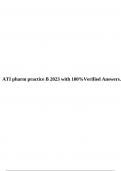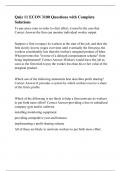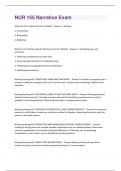METHODEN VAN HET
WETENSCHAPPELIJK
ONDERZOEK
Academiejaar ’23 – ‘24
,INHOUDSOPGAVE
H1: INLEIDING .............................................................................................................................. 1
NIET-WETENSCHAPPELIJKE METHODEN ....................................................................................................... 1
Vasthoudendheid (tenacity) .......................................................................................................... 1
Intuïtie ......................................................................................................................................... 1
Autoriteit ..................................................................................................................................... 1
Rationalisme ............................................................................................................................... 1
Empirie........................................................................................................................................ 2
WETENSCHAPPELIJK METHODE ................................................................................................................. 2
Stappen....................................................................................................................................... 2
Stap 1: observatie van gedrag of andere fenomenen ................................................................................... 2
Stap 2: hypotheses vormen ....................................................................................................................... 3
Stap 3: predicties vormen.......................................................................................................................... 3
Stap 4 : evalueer de predictie o.b.v. systematische, geplande observaties................................................... 3
Stap 5: gebruik de observaties om de hypothese te ondersteunen, weerleggen of herspecifiëren ................. 4
3 belangrijke principes ................................................................................................................. 4
Wetenschap is empirisch .......................................................................................................................... 4
Wetenschap is openbaar .......................................................................................................................... 4
Wetenschap is objectief ............................................................................................................................ 4
Wetenschap vs pseudowetenschap.............................................................................................. 4
DE EMPIRISCHE CYCLUS ......................................................................................................................... 5
Kwantitatief en kwalitatief onderzoek ............................................................................................ 5
Stappen....................................................................................................................................... 5
Stap 1: ontwikkelen van onderzoeksidee .................................................................................................... 5
Stap 2: vorm een hypothese ...................................................................................................................... 5
stap 3: bepaal hoe je jouw variabelen zal definiëren en meten..................................................................... 5
stap 4: identificeer participanten voor studie.............................................................................................. 6
stap 5: selecteer onderzoeksstrategie........................................................................................................ 6
Stap 6: selecteer onderzoeksdesign........................................................................................................... 6
Stap 7: voer studie uit................................................................................................................................ 6
Stap 8: evalueer data ................................................................................................................................ 6
Stap 9: rapporteer resultaten ..................................................................................................................... 6
stap 10: verfijn of herformuleer je onderzoeksidee ...................................................................................... 6
H2: HYPOTHESEN FORMULEREN (STAP 2 EMPIRISCHE CYCLUS) .................................................... 7
KENMERKEN VAN EEN GOEDE HYPOTHESE ................................................................................................... 7
Logisch ....................................................................................................................................... 7
Toetsbaar .................................................................................................................................... 7
Weerlegbaar ................................................................................................................................ 7
Positief ........................................................................................................................................ 7
H3: VARIABELEN DEFINIËREN EN METEN (STAP 3 EMPIRISCHE CYCLUS)......................................... 8
CONSTRUCTEN EN OPERATIONELE DEFINITIES............................................................................................... 8
Theorieën en constructen ............................................................................................................. 8
Operationele definities ................................................................................................................. 8
VALDITEIT EN BETROUWBAARHEID ............................................................................................................. 9
Validiteit van een meting .............................................................................................................. 9
Betrouwbaarheid van een meting .................................................................................................10
Types betrouwbaarheid ............................................................................................................................10
Relatie validiteit – betrouwbaarheid .............................................................................................11
, MEETSCHALEN ................................................................................................................................... 11
Nominale meetschaal .................................................................................................................11
Ordinale meetschaal...................................................................................................................11
Interval meetschaal ....................................................................................................................12
Ratio meetschaal ........................................................................................................................12
Kiezen van meetschaal................................................................................................................12
MEETMODALITEITEN ............................................................................................................................. 12
Zelfrapportage ............................................................................................................................12
Fysiologie ...................................................................................................................................13
Gedragsmaten ............................................................................................................................13
ANDERE ASPECTEN VAN METEN ............................................................................................................... 13
Multipele metingen .....................................................................................................................13
Sensiviteit ...................................................................................................................................13
Artefacten ..................................................................................................................................14
Proefleider bias (observer/experimenter bias) ...........................................................................................14
Vraagkarakteristieken (demand characteristics) en participant reactiviteit .................................................14
H4: PARTICIPANTEN SELECTEREN (STAP 4 EMPIRISCHE CYLCUS) ................................................. 15
INTRODUCTIE TOT STEEKPROEFTREKKING .................................................................................................. 15
Populaties en steekproeven ........................................................................................................15
Representatieve steekproeven ....................................................................................................15
Steekproefgrootte .......................................................................................................................15
PROBABILITY SAMPLING ........................................................................................................................ 16
Simple random sampling.............................................................................................................16
2 methoden .............................................................................................................................................16
Met teruglegging ..................................................................................................................................16
Zonder teruglegging .............................................................................................................................16
Systematische sampling .............................................................................................................17
Gestratificieerde random sampling ..............................................................................................17
Proportionele gestratificeerde random sampling ..........................................................................17
Cluster sampling.........................................................................................................................17
NONPROBABILTY SAMPLING ................................................................................................................... 18
Convenience sampling ................................................................................................................18
Quota sampling ..........................................................................................................................18
H5: ONDERZOEKSSTRATEGIEËN EN VALIDITEIT (STAP 5 EMPRISICHE CYCLUS) .............................. 19
ONDERZOEKSSTRATEGIEËN ................................................................................................................... 19
Beschrijvend (zie H13) .................................................................................................................19
Correlationeel (zie H12) ...............................................................................................................19
Experimenteel (zie H6/H7/H8) .....................................................................................................20
Quasi-experimenteel (zie H9) ......................................................................................................20
Non-experimenteel (zie H9) .........................................................................................................20
EXTERNE EN INTERNE VALIDITEIT.............................................................................................................. 20
Externe validiteit .........................................................................................................................20
Bedreigingen van externe validiteit ............................................................................................................21
Generaliseren over participanten .........................................................................................................21
Generaliseren over kenmerken van een studie ......................................................................................21
Generaliseren over kenmerken van de metingen ...................................................................................21
Interne validiteit ..........................................................................................................................21
Bedreigingen van interne validiteit ............................................................................................................22
Bijkomende (extraneous) variabelen .....................................................................................................22
, Storende (confounding) variabele .........................................................................................................22
Omgevingsvariabelen ......................................................................................................................22
Participant variabelen .....................................................................................................................22
Tijdsgerelateerde variabelen ............................................................................................................22
Meer over interne en externe validiteit ..........................................................................................23
Interne en externe validiteit balanceren ....................................................................................................23
Artefacten ...............................................................................................................................................23
Overdreven variabelen .............................................................................................................................23
Validiteit en individuele onderzoekstrategieën ..........................................................................................23
H6: EXPERIMENTELE ONDERZOEKSSTRATEGIE (STAP 5 EMPIRISCHE CYCLUS) .............................. 24
OORZAAK-GEVOLG RELATIES .................................................................................................................. 24
Terminologie...............................................................................................................................24
Problemen..................................................................................................................................25
2 ELEMENTEN ESSENTIEEL VOOR EXPERIMENTEEL EXPERIMENT ........................................................................ 25
Manipulatie ................................................................................................................................25
Controle .....................................................................................................................................25
BIJKOMENDE VARIABELEN CONTROLEREN .................................................................................................. 26
3 methoden ................................................................................................................................26
Variabele constant houden ......................................................................................................................26
Matching .................................................................................................................................................26
Randomiseren .........................................................................................................................................26
CONTROLE CONDITIES ......................................................................................................................... 27
2 categorieën ..............................................................................................................................27
Geen behandeling controle condities .......................................................................................................27
Placebo controle condities .......................................................................................................................27
MANIPULATIE CHECKS .......................................................................................................................... 27
EXTERNE VALIDITEIT VERHOGEN .............................................................................................................. 28
H7: EXPERIMENTEEL DESIGN – TUSSEN-SUBJECT DESIGNS (STAP 6 EMPIRISCHE CYCLUS) ............ 29
KARAKTERISTIEKEN .............................................................................................................................. 29
VOOR- EN NADELEN............................................................................................................................. 29
Individuele verschillen ................................................................................................................29
INDIVIDUELE VERSCHILLEN ALS STORENDE VARIABELE .................................................................................. 30
INDIVIDUELE VERSCHILLEN EN VARIABILITEIT .............................................................................................. 30
ANDERE BEDREIGINGEN VAN INTERNE VALIDITEIT ......................................................................................... 31
Drop-out.....................................................................................................................................31
Communicatie tussen groepen ....................................................................................................31
H8: EXPERIMENTEEL DESIGN – BINNEN-SUBJECT DESIGNS (STAP 6 EMPIRISCHE CYCLUS) ............ 32
KARAKTERISTIEKEN .............................................................................................................................. 32
BEDREIGINGEN VOOR INTERNE VALIDITEIT ................................................................................................. 32
Omgevingsvariabelen..................................................................................................................32
Tijdsgerelateerde variabelen ........................................................................................................32
History ....................................................................................................................................................32
Maturatie.................................................................................................................................................32
Instrumentatie .........................................................................................................................................33
Statistische regressie ...............................................................................................................................33
Orde effecten ..........................................................................................................................................33
OMGAAN MET TIJDSGERELATEERDE BEDREIGINGEN ...................................................................................... 34
Tijd controleren...........................................................................................................................34
Ga over op een tussen-subject design ..........................................................................................34
WETENSCHAPPELIJK
ONDERZOEK
Academiejaar ’23 – ‘24
,INHOUDSOPGAVE
H1: INLEIDING .............................................................................................................................. 1
NIET-WETENSCHAPPELIJKE METHODEN ....................................................................................................... 1
Vasthoudendheid (tenacity) .......................................................................................................... 1
Intuïtie ......................................................................................................................................... 1
Autoriteit ..................................................................................................................................... 1
Rationalisme ............................................................................................................................... 1
Empirie........................................................................................................................................ 2
WETENSCHAPPELIJK METHODE ................................................................................................................. 2
Stappen....................................................................................................................................... 2
Stap 1: observatie van gedrag of andere fenomenen ................................................................................... 2
Stap 2: hypotheses vormen ....................................................................................................................... 3
Stap 3: predicties vormen.......................................................................................................................... 3
Stap 4 : evalueer de predictie o.b.v. systematische, geplande observaties................................................... 3
Stap 5: gebruik de observaties om de hypothese te ondersteunen, weerleggen of herspecifiëren ................. 4
3 belangrijke principes ................................................................................................................. 4
Wetenschap is empirisch .......................................................................................................................... 4
Wetenschap is openbaar .......................................................................................................................... 4
Wetenschap is objectief ............................................................................................................................ 4
Wetenschap vs pseudowetenschap.............................................................................................. 4
DE EMPIRISCHE CYCLUS ......................................................................................................................... 5
Kwantitatief en kwalitatief onderzoek ............................................................................................ 5
Stappen....................................................................................................................................... 5
Stap 1: ontwikkelen van onderzoeksidee .................................................................................................... 5
Stap 2: vorm een hypothese ...................................................................................................................... 5
stap 3: bepaal hoe je jouw variabelen zal definiëren en meten..................................................................... 5
stap 4: identificeer participanten voor studie.............................................................................................. 6
stap 5: selecteer onderzoeksstrategie........................................................................................................ 6
Stap 6: selecteer onderzoeksdesign........................................................................................................... 6
Stap 7: voer studie uit................................................................................................................................ 6
Stap 8: evalueer data ................................................................................................................................ 6
Stap 9: rapporteer resultaten ..................................................................................................................... 6
stap 10: verfijn of herformuleer je onderzoeksidee ...................................................................................... 6
H2: HYPOTHESEN FORMULEREN (STAP 2 EMPIRISCHE CYCLUS) .................................................... 7
KENMERKEN VAN EEN GOEDE HYPOTHESE ................................................................................................... 7
Logisch ....................................................................................................................................... 7
Toetsbaar .................................................................................................................................... 7
Weerlegbaar ................................................................................................................................ 7
Positief ........................................................................................................................................ 7
H3: VARIABELEN DEFINIËREN EN METEN (STAP 3 EMPIRISCHE CYCLUS)......................................... 8
CONSTRUCTEN EN OPERATIONELE DEFINITIES............................................................................................... 8
Theorieën en constructen ............................................................................................................. 8
Operationele definities ................................................................................................................. 8
VALDITEIT EN BETROUWBAARHEID ............................................................................................................. 9
Validiteit van een meting .............................................................................................................. 9
Betrouwbaarheid van een meting .................................................................................................10
Types betrouwbaarheid ............................................................................................................................10
Relatie validiteit – betrouwbaarheid .............................................................................................11
, MEETSCHALEN ................................................................................................................................... 11
Nominale meetschaal .................................................................................................................11
Ordinale meetschaal...................................................................................................................11
Interval meetschaal ....................................................................................................................12
Ratio meetschaal ........................................................................................................................12
Kiezen van meetschaal................................................................................................................12
MEETMODALITEITEN ............................................................................................................................. 12
Zelfrapportage ............................................................................................................................12
Fysiologie ...................................................................................................................................13
Gedragsmaten ............................................................................................................................13
ANDERE ASPECTEN VAN METEN ............................................................................................................... 13
Multipele metingen .....................................................................................................................13
Sensiviteit ...................................................................................................................................13
Artefacten ..................................................................................................................................14
Proefleider bias (observer/experimenter bias) ...........................................................................................14
Vraagkarakteristieken (demand characteristics) en participant reactiviteit .................................................14
H4: PARTICIPANTEN SELECTEREN (STAP 4 EMPIRISCHE CYLCUS) ................................................. 15
INTRODUCTIE TOT STEEKPROEFTREKKING .................................................................................................. 15
Populaties en steekproeven ........................................................................................................15
Representatieve steekproeven ....................................................................................................15
Steekproefgrootte .......................................................................................................................15
PROBABILITY SAMPLING ........................................................................................................................ 16
Simple random sampling.............................................................................................................16
2 methoden .............................................................................................................................................16
Met teruglegging ..................................................................................................................................16
Zonder teruglegging .............................................................................................................................16
Systematische sampling .............................................................................................................17
Gestratificieerde random sampling ..............................................................................................17
Proportionele gestratificeerde random sampling ..........................................................................17
Cluster sampling.........................................................................................................................17
NONPROBABILTY SAMPLING ................................................................................................................... 18
Convenience sampling ................................................................................................................18
Quota sampling ..........................................................................................................................18
H5: ONDERZOEKSSTRATEGIEËN EN VALIDITEIT (STAP 5 EMPRISICHE CYCLUS) .............................. 19
ONDERZOEKSSTRATEGIEËN ................................................................................................................... 19
Beschrijvend (zie H13) .................................................................................................................19
Correlationeel (zie H12) ...............................................................................................................19
Experimenteel (zie H6/H7/H8) .....................................................................................................20
Quasi-experimenteel (zie H9) ......................................................................................................20
Non-experimenteel (zie H9) .........................................................................................................20
EXTERNE EN INTERNE VALIDITEIT.............................................................................................................. 20
Externe validiteit .........................................................................................................................20
Bedreigingen van externe validiteit ............................................................................................................21
Generaliseren over participanten .........................................................................................................21
Generaliseren over kenmerken van een studie ......................................................................................21
Generaliseren over kenmerken van de metingen ...................................................................................21
Interne validiteit ..........................................................................................................................21
Bedreigingen van interne validiteit ............................................................................................................22
Bijkomende (extraneous) variabelen .....................................................................................................22
, Storende (confounding) variabele .........................................................................................................22
Omgevingsvariabelen ......................................................................................................................22
Participant variabelen .....................................................................................................................22
Tijdsgerelateerde variabelen ............................................................................................................22
Meer over interne en externe validiteit ..........................................................................................23
Interne en externe validiteit balanceren ....................................................................................................23
Artefacten ...............................................................................................................................................23
Overdreven variabelen .............................................................................................................................23
Validiteit en individuele onderzoekstrategieën ..........................................................................................23
H6: EXPERIMENTELE ONDERZOEKSSTRATEGIE (STAP 5 EMPIRISCHE CYCLUS) .............................. 24
OORZAAK-GEVOLG RELATIES .................................................................................................................. 24
Terminologie...............................................................................................................................24
Problemen..................................................................................................................................25
2 ELEMENTEN ESSENTIEEL VOOR EXPERIMENTEEL EXPERIMENT ........................................................................ 25
Manipulatie ................................................................................................................................25
Controle .....................................................................................................................................25
BIJKOMENDE VARIABELEN CONTROLEREN .................................................................................................. 26
3 methoden ................................................................................................................................26
Variabele constant houden ......................................................................................................................26
Matching .................................................................................................................................................26
Randomiseren .........................................................................................................................................26
CONTROLE CONDITIES ......................................................................................................................... 27
2 categorieën ..............................................................................................................................27
Geen behandeling controle condities .......................................................................................................27
Placebo controle condities .......................................................................................................................27
MANIPULATIE CHECKS .......................................................................................................................... 27
EXTERNE VALIDITEIT VERHOGEN .............................................................................................................. 28
H7: EXPERIMENTEEL DESIGN – TUSSEN-SUBJECT DESIGNS (STAP 6 EMPIRISCHE CYCLUS) ............ 29
KARAKTERISTIEKEN .............................................................................................................................. 29
VOOR- EN NADELEN............................................................................................................................. 29
Individuele verschillen ................................................................................................................29
INDIVIDUELE VERSCHILLEN ALS STORENDE VARIABELE .................................................................................. 30
INDIVIDUELE VERSCHILLEN EN VARIABILITEIT .............................................................................................. 30
ANDERE BEDREIGINGEN VAN INTERNE VALIDITEIT ......................................................................................... 31
Drop-out.....................................................................................................................................31
Communicatie tussen groepen ....................................................................................................31
H8: EXPERIMENTEEL DESIGN – BINNEN-SUBJECT DESIGNS (STAP 6 EMPIRISCHE CYCLUS) ............ 32
KARAKTERISTIEKEN .............................................................................................................................. 32
BEDREIGINGEN VOOR INTERNE VALIDITEIT ................................................................................................. 32
Omgevingsvariabelen..................................................................................................................32
Tijdsgerelateerde variabelen ........................................................................................................32
History ....................................................................................................................................................32
Maturatie.................................................................................................................................................32
Instrumentatie .........................................................................................................................................33
Statistische regressie ...............................................................................................................................33
Orde effecten ..........................................................................................................................................33
OMGAAN MET TIJDSGERELATEERDE BEDREIGINGEN ...................................................................................... 34
Tijd controleren...........................................................................................................................34
Ga over op een tussen-subject design ..........................................................................................34











